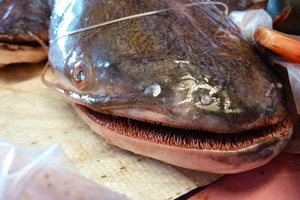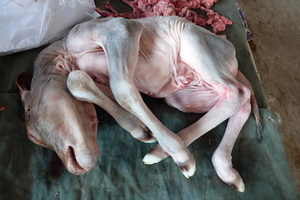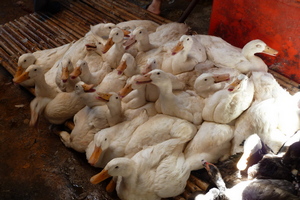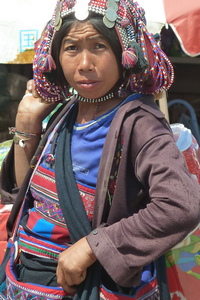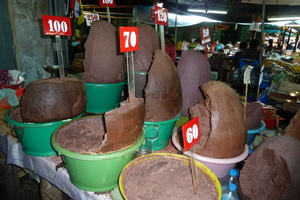Market Stuff
(thomas;2012-Jul-11)
The local wet markets are one of the greatest joys of travelling through SE Asia although there are huge variations: in Malaysia, most markets are relatively tame affairs as many Malaysians do most of their shopping in supermarkets anyway. By contrast, in Cambodia, the wet markets are a delight — if you can stand the dirt and blood, the smells and the way animals are treated there. Believe us: there's nothing you can't buy in these markets… you just have to be patient and look hard enough for it.
One thing we found amazing is this: even after spending many months in the region (we're now there for the third time in six years) there's always another unfamiliar type of fruit or vegetable in someone's stall, just when you thought you'd seen or tasted everything. The sheer variety is overwhelming.
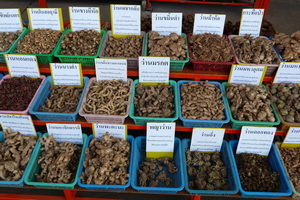 Nong Khai, Thailand: This is one of many market stalls selling all sorts of dried plants, herbs, roots, barks (you get the idea…) for alternative medicine. The Thais are big believers in alternative medicine and you can easily watch two or more people standing at such a stall and discussing the relative merits of this herb vs that one or that cure vs the other one. For us, the uninitiated Westerners, the smells of these various “drugs” were more interesting than their real or imaginary healing capabilities.
Nong Khai, Thailand: This is one of many market stalls selling all sorts of dried plants, herbs, roots, barks (you get the idea…) for alternative medicine. The Thais are big believers in alternative medicine and you can easily watch two or more people standing at such a stall and discussing the relative merits of this herb vs that one or that cure vs the other one. For us, the uninitiated Westerners, the smells of these various “drugs” were more interesting than their real or imaginary healing capabilities.
Mukdahan, Thailand: that's a catfish, fresh from the Mekong. This was a relatively big fish, a good two feet long and with a weight of perhaps some five kilogrammes. However, among Mekong catfish a specimen like that is almost a dwarf: there are catfish in the Mekong which are bigger and heavier than a human. Sadly, they are an endangered species.
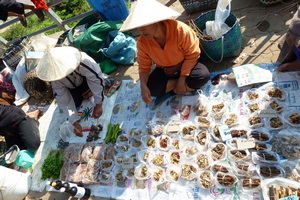 That Phanom, Thailand: this snap was taken during the weekly Lao traders' market. Every Sunday Laotian traders cross the Mekong and offer all sorts of traditional products. These two ladies sell dried roots, herbs… in short the same stuff as in the first pic. There are others who sell grisly looking dried animals, bundles of boar bristles, animal horns, teeth and bones… quite some choice!
That Phanom, Thailand: this snap was taken during the weekly Lao traders' market. Every Sunday Laotian traders cross the Mekong and offer all sorts of traditional products. These two ladies sell dried roots, herbs… in short the same stuff as in the first pic. There are others who sell grisly looking dried animals, bundles of boar bristles, animal horns, teeth and bones… quite some choice!
That Phanom, Thailand: in the same market, in the Thai section for meat sellers, we found this newborn calf, dead. This just proves that you can buy anything in Thailand.
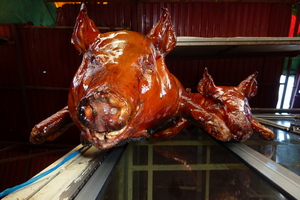 Phnom Penh, Cambodia: two spit-roasted pigs which were hanging from the roof of a stall. We carefully positioned the camera on the shelf below them (trying to avoid the dripping fat) and took this shot, upwards.
Phnom Penh, Cambodia: two spit-roasted pigs which were hanging from the roof of a stall. We carefully positioned the camera on the shelf below them (trying to avoid the dripping fat) and took this shot, upwards.
Phnom Penh, Cambodia: yeah, those ducks were still very alive when we saw them but clearly it wouldn't take too long until all birds in this happy group would be going to the cooking pot. The buyer chooses his or her favourite meal, then the market woman (it's always women doing these jobs) expertly kills the bird and roughly plucks it, gets out and cleans the giblets, packs everything up into a neat bundle, hands it over and receives a few dollars from the buyer (in Cambodia many things are paid for in US dollars). And all are happy (with the exception of the ducks).
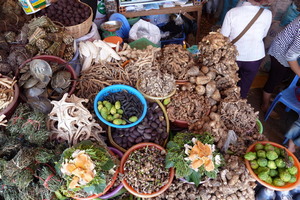 Phnom Penh, Cambodia: alongside the main market (called O'Russey) runs a street full with stall after stall after stall selling traditional medicines, very much along the lines of the stall shown further up. The really amazing bit here is the sheer variety of stuff: outside there are all sorts of herbs, spices, roots and mushrooms; inside there is a not unpleasant smell and box after box after box with powders, small bottles, tiny packs of unidentifiable substances…
Phnom Penh, Cambodia: alongside the main market (called O'Russey) runs a street full with stall after stall after stall selling traditional medicines, very much along the lines of the stall shown further up. The really amazing bit here is the sheer variety of stuff: outside there are all sorts of herbs, spices, roots and mushrooms; inside there is a not unpleasant smell and box after box after box with powders, small bottles, tiny packs of unidentifiable substances…
Udomxai, Laos: this lady is doing her weekly shopping in the Udomxai market. She's from the Akha hill tribe, one of a few tribes which live around town. She was part of a larger group which came to town on a big truck, laughing and smiling and waving frantically.
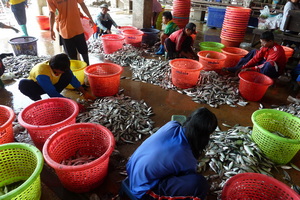 Samut Sakhon, Thailand: this town, about 30 km southwest of Bangkok, harbours one of the largest and most impressive markets for fresh seawater produce in all of Thailand. There must be hundreds of stalls with all imaginable (and some unimaginable) sea creatures. The various smells and reeks are just as amazing as the sights.
Samut Sakhon, Thailand: this town, about 30 km southwest of Bangkok, harbours one of the largest and most impressive markets for fresh seawater produce in all of Thailand. There must be hundreds of stalls with all imaginable (and some unimaginable) sea creatures. The various smells and reeks are just as amazing as the sights.
These guys are sorting the latest catch into separate buckets, according to size, and they are really, really fast.
Samut Sakhon, Thailand: still in the fish market. These buckets contain fermented fish paste. This sounds worse than it tastes but we readily admit that it's an acquired taste (then again, so is Marmite). However, a fresh noodle soup without a good chunk of this paste or fish sauce, which is similar, is just not complete. The figures give the price, in Baht, per kilogramme which, in turn, relates to the type and quality of the fish used and the length of fermentation.
We sampled several and honestly, we couldn't taste much of a difference. However, Thai aficionados have told us that there's a world of difference between cheap and premium fish paste (incidentally, these are made of just pounded fish and salt). Well, that's probably not dissimilar to what French cheese buffs would say about some obscure cheese varieties (Epoisses and Pont-l'évêque come to mind).
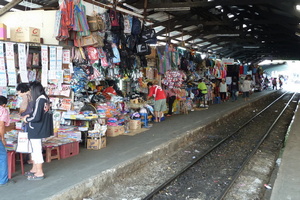
Samut Sakhon, Thailand: this is the end of the railway from Bangkok… so Mahachai station is the market (or vice versa). There are many stalls alongside the rails, left and right; some traders actually put their wares onto the rails and remove them temporarily if a train arrives or leaves (there are only four trains a day, so it's not too bad).
Want to read more? Go back to Cobras and Other Creatures or go on to An Umbrella For Two or go up to Blog
$ updated from: Blog.htxt Mon 28 Apr 2025 14:55:32 trvl2 — Copyright © 2025 Vero and Thomas Lauer unless otherwise stated | All rights reserved $




